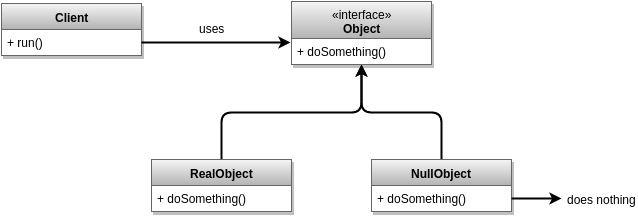Null object design pattern is a software design pattern where the null object replaces the checking for null values. It defines the default behavior of some service class method and does nothing.

Below is a simple example of different types of commands and an application which uses them.
<?php
interface CommandInterface
{
public function execute();
}
class OutputCommand implements CommandInterface
{
public function execute()
{
echo 'Output from the command';
}
}
class FileCommand implements CommandInterface
{
public function execute()
{
file_put_contents(__DIR__.'/log.txt', date('Y-m-d H:i:s'), FILE_APPEND | LOCK_EX);
}
}
class NullCommand implements CommandInterface
{
public function execute()
{
// Do nothing.
}
}
class Application
{
public function run(CommandInterface $command = null)
{
$executableCommand = $command ?? new NullCommand();
return $executableCommand->execute();
}
}
Usage is then the following:
<?php
// ...
$outputCommand = new OutputCommand();
$fileCommand = new FileCommand();
$app = new Application();
// Echo predefined string
$application->run($outputCommand); // Output from the command
// Create a file and append string to it
$application->run($fileCommand);
// Do nothing
$application->run();
If we run the application without providing it the command, it does nothing,
because in that case it uses the null object NullCommand. Without the null
object, we would have to check that in the client code which becomes messy as
more commands are added or in more complex situations.
Some examples of the null object design pattern implementations in open source: